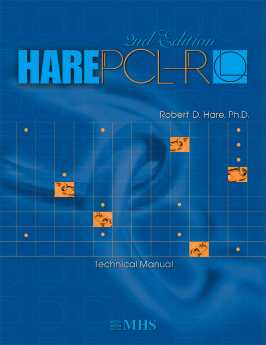Psychopathy Checklist
Psychopathy Checklist (PCL) is a psychological assessment tool most commonly used to assess the presence of psychopathy in individuals. It was developed by Canadian psychologist Robert D. Hare in the 1970s and has undergone revisions, leading to the current version known as the Psychopathy Checklist-Revised (PCL-R). The checklist is widely used in clinical settings, forensic psychology, and research into psychopathic behavior.
Development and Structure[edit | edit source]
The original Psychopathy Checklist was developed based on Hare's research and clinical observations of individuals diagnosed as psychopathic. The revised version, the PCL-R, consists of a 20-item inventory of perceived personality traits and observed behaviors, each scored on a three-point scale (0, 1, 2) based on the extent to which a statement applies to the individual being assessed. The total possible score is 40, with scores above a certain threshold (typically 30 in the United States and 25 in the United Kingdom) indicating a diagnosis of psychopathy.
The items on the PCL-R cover a range of factors associated with psychopathy, including glibness/superficial charm, grandiose sense of self-worth, need for stimulation/proneness to boredom, pathological lying, cunning/manipulative behavior, lack of remorse or guilt, shallow affect, callous/lack of empathy, parasitic lifestyle, poor behavioral controls, sexual promiscuity, early behavior problems, lack of realistic long-term goals, impulsivity, irresponsibility, failure to accept responsibility for own actions, many short-term marital relationships, juvenile delinquency, revocation of conditional release, and criminal versatility.
Applications[edit | edit source]
The PCL-R is used in various settings, including clinical assessments, forensic evaluations, and research. In forensic settings, it is often used to assess the risk of recidivism or to guide sentencing decisions. In clinical settings, it can help with the diagnosis and treatment planning for individuals with psychopathic traits. Researchers use the PCL-R to study the nature, prevalence, and causes of psychopathy.
Criticism and Controversy[edit | edit source]
Despite its widespread use, the PCL-R has been subject to criticism. Some critics argue that the tool may be biased against certain groups, such as those from different cultural backgrounds or socioeconomic statuses. Others have raised concerns about the reliability and validity of the tool, particularly when used by non-experts or in non-forensic settings. There is also debate about the ethical implications of labeling individuals as psychopaths, given the potential for stigma and discrimination.
Conclusion[edit | edit source]
The Psychopathy Checklist-Revised remains a key tool in the assessment of psychopathy, with significant implications for clinical practice, the criminal justice system, and research into antisocial behavior. Despite its controversies, it provides valuable insights into the understanding of psychopathic traits and behaviors, contributing to the development of targeted interventions and management strategies for individuals with psychopathic tendencies.
This article is a psychology-related stub. You can help WikiMD by expanding it!
Search WikiMD
Ad.Tired of being Overweight? Try W8MD's physician weight loss program.
Semaglutide (Ozempic / Wegovy and Tirzepatide (Mounjaro / Zepbound) available.
Advertise on WikiMD
|
WikiMD's Wellness Encyclopedia |
| Let Food Be Thy Medicine Medicine Thy Food - Hippocrates |
Translate this page: - East Asian
中文,
日本,
한국어,
South Asian
हिन्दी,
தமிழ்,
తెలుగు,
Urdu,
ಕನ್ನಡ,
Southeast Asian
Indonesian,
Vietnamese,
Thai,
မြန်မာဘာသာ,
বাংলা
European
español,
Deutsch,
français,
Greek,
português do Brasil,
polski,
română,
русский,
Nederlands,
norsk,
svenska,
suomi,
Italian
Middle Eastern & African
عربى,
Turkish,
Persian,
Hebrew,
Afrikaans,
isiZulu,
Kiswahili,
Other
Bulgarian,
Hungarian,
Czech,
Swedish,
മലയാളം,
मराठी,
ਪੰਜਾਬੀ,
ગુજરાતી,
Portuguese,
Ukrainian
Medical Disclaimer: WikiMD is not a substitute for professional medical advice. The information on WikiMD is provided as an information resource only, may be incorrect, outdated or misleading, and is not to be used or relied on for any diagnostic or treatment purposes. Please consult your health care provider before making any healthcare decisions or for guidance about a specific medical condition. WikiMD expressly disclaims responsibility, and shall have no liability, for any damages, loss, injury, or liability whatsoever suffered as a result of your reliance on the information contained in this site. By visiting this site you agree to the foregoing terms and conditions, which may from time to time be changed or supplemented by WikiMD. If you do not agree to the foregoing terms and conditions, you should not enter or use this site. See full disclaimer.
Credits:Most images are courtesy of Wikimedia commons, and templates, categories Wikipedia, licensed under CC BY SA or similar.
Contributors: Prab R. Tumpati, MD

